Related Research Articles
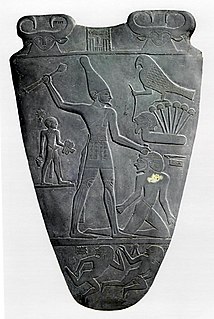
Narmer was an ancient Egyptian pharaoh of the Early Dynastic Period. He was the successor to the Protodynastic king Ka. Some consider him the unifier of Egypt and founder of the First Dynasty, and in turn the first king of a unified Egypt. A majority of Egyptologists believe that Narmer was the same person as Menes.

Scorpion II, also known as King Scorpion, was a ruler during the Protodynastic Period of Upper Egypt.

Merneith was a consort and a regent of Ancient Egypt during the First Dynasty. She may have been a ruler of Egypt in her own right, based on several official records. If this was the case and the earlier royal wife Neithhotep never ruled as an independent regent, Merneith may have been the first female pharaoh and the earliest queen regnant in recorded history. Her rule occurred around 2950 BC for an undetermined period. Merneith’s name means "Beloved by Neith" and her stele contains symbols of that ancient Egyptian deity. She may have been Djer's daughter and was probably Djet's senior royal wife. The former meant that she would have been the great-granddaughter of unified Egypt's first pharaoh, Narmer. She was also the mother of Den, her successor.

Iry-Hor or Ro was a predynastic pharaoh of Upper Egypt during the 32nd century BC. Iry-Hor's existence was debated, with the Egyptologist Toby Wilkinson contesting the reading and signification of his name. However, continuing excavations at Abydos in the 1980s and 1990s and the discovery in 2012 of an inscription of Iry-Hor in the Sinai confirmed his existence. Iry-Hor is the earliest ruler of Egypt known by name and is sometimes cited as the earliest-living historical person known by name.
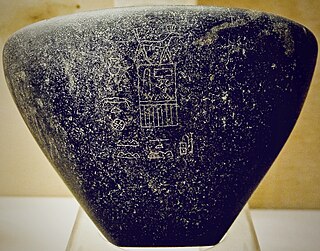
Seth-Peribsen is the serekh name of an early Egyptian monarch (pharaoh), who ruled during the Second Dynasty of Egypt. His chronological position within this dynasty is unknown and it is disputed who ruled both before and after him. The duration of his reign is also unknown.
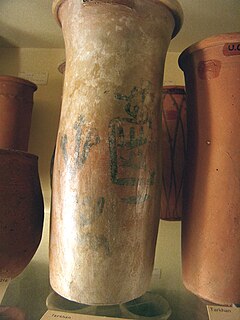
Ka, also (alternatively) Sekhen, was a Predynastic pharaoh of Upper Egypt belonging to Dynasty 0. He probably reigned during the first half of the 32nd century BC. The length of his reign is unknown.
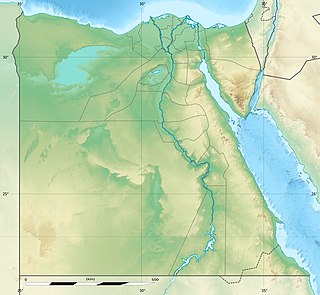
Naqada III is the last phase of the Naqada culture of ancient Egyptian prehistory, dating from approximately 3200 to 3000 BC. It is the period during which the process of state formation, which began in Naqada II, became highly visible, with named kings heading powerful polities. Naqada III is often referred to as Dynasty 0 or the Protodynastic Period to reflect the presence of kings at the head of influential states, although, in fact, the kings involved would not have been a part of a dynasty. In this period, those kings' names were inscribed in the form of serekhs on a variety of surfaces including pottery and tombs.
Scorpion I was a ruler of Upper Egypt during Naqada III. His name may refer to the scorpion goddess Serket, though evidence suggests Serket's rise in popularity to be in the Old Kingdom, bringing doubt to whether Scorpion actually took his name from her. He was one of the first rulers of Ancient Egypt.
Günter Dreyer was an Egyptologist at the German Archaeological Institute. In southern Egypt, Dreyer discovered records of linen and oil deliveries which have been carbon-dated to between 3300 BCE and 3200 BCE, predating the Dynastic Period.
The dynastic race theory was the earliest thesis to attempt to explain how predynastic Egypt developed into the sophisticated monarchy of Dynastic Egypt. The theory holds that the earliest roots of the ancient Egyptian dynastic civilisation were imported by invaders from Mesopotamia who then founded the First Dynasty and brought culture to the indigenous population. This theory had strong supporters in the Egyptological community in the first half of the 20th century, but has since lost mainstream support.
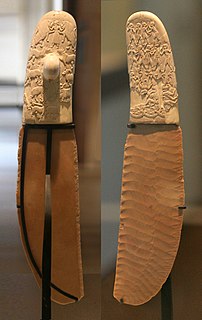
The Gebel el-Arak Knife, also Jebel el-Arak Knife, is an ivory and flint knife dating from the Naqada II period of Egyptian prehistory, starting circa 3450 BC, showing Mesopotamian influence. The knife was purchased in 1914 in Cairo by Georges Aaron Bénédite for the Louvre, where it is now on display in the Sully wing, room 20. At the time of its purchase, the knife handle was alleged by the seller to have been found at the site of Gebel el-Arak, but it is today believed to come from Abydos.

The Naqada culture is an archaeological culture of Chalcolithic Predynastic Egypt, named for the town of Naqada, Qena Governorate. A 2013 Oxford University radio carbon dating study of the Predynastic period, however, suggests a much later date beginning sometime between 3,800–3,700 BC.

Neithhotep or Neith-hotep was an ancient Egyptian queen consort living and ruling during the early First Dynasty. She was once thought to be a male ruler: her outstandingly large mastaba and the royal serekh surrounding her name on several seal impressions previously led Egyptologists and historians to the erroneous belief that she may have been an unknown king.

Double Falcon was a ruler of Lower Egypt from Naqada III. He may have reigned during the 32nd century BCE. The length of his reign is unknown.
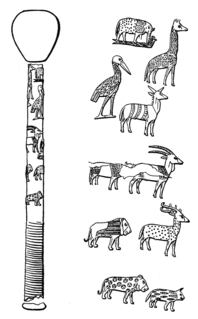
The Sayala Mace or Seyala Mace is a ceremonial mace made of gold plated wood and stone, from Predynastic Egypt. It was found by Cecil Mallaby Firth in 1910/11 at Sayala in Lower Nubia and subsequently kept in the Egyptian Museum in Cairo until it was stolen in 1920. Its later fate is unknown. The mace is especially significant for the detailed depictions of animals on its handle.
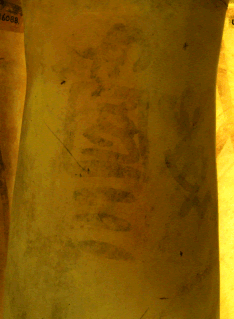
Crocodile is the provisional name of a predynastic ruler, who might have ruled during the late Naqada III epoch. The few alleged ink inscriptions showing his name are drawn very sloppily, and the reading and thus whole existence of king "Crocodile" are highly disputed. His tomb is unknown.

Elephant is the provisional name of a Predynastic ruler in Egypt. Since the incarved rock inscriptions and ivory tags showing his name are either drawn sloppily, or lacking any royal crest, the reading and thus whole existence of king "Elephant" are highly disputed.
Hedju Hor was a ruler in northern Egypt from the Predynastic Period. His existence is controversial.

Ny-Hor was a possible pharaoh from the Predynastic Period. His name means "The Hunter". He may have ruled during the 31st century BCE.
Pharaoh Finger snail was an ancient Egyptian ruler (Pharaoh) from the pre-Dynastic period of prehistoric Egypt. It is disputed whether he really existed as the reading of his name as king's name is far from certain. Most scholars do not read the known signs as king's name. He may have been the first king of a united upper Egypt.
References
- ↑ Jürgen Schraten, Zur Aktualität von Jan Assmann: Einleitung in sein Werk (Springer-Verlag, 11.11.2010) page 59.
- ↑ Günter Dreyer: Umm el-Qaab I .: the predynastic royal tomb U-j and its early documents (= Umm el-Qaab, 1st volume). von Zabern, Mainz 1998, ISBN 3-8053-2486-3., pp. 87 & 176.
- 1 2 3 Ludwig David Morenz: picture letters and symbolic signs. The development of the writing of the high culture of ancient Egypt (= Orbis Biblicus et Orientalis 205). Friborg 2004, ISBN 3-7278-1486-1., pp. 130-134, 172, 190-193.
- ↑ Gregory Phillip Gilbert: Weapons, warriors and warfare in early Egypt. 2004, (= BAR international series. Volume 1208). Archaeopress, 2004, ISBN 1-84171-571-9. pp. 93 & 94.
- ↑ Wolfgang Helck: Studies on the Thinite period (= Egyptological treatises. (ÄA) Vol. 45). Harrassowitz, Wiesbaden 1987, ISBN 3-447-02677-4, (restricted online version), pp. 147 & 153.